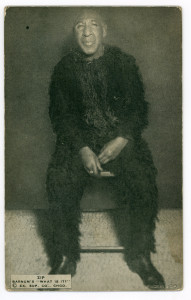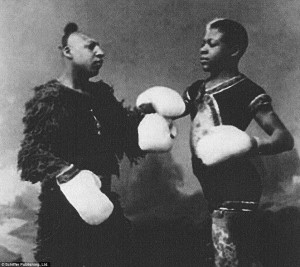 To celebrate Black History Month, I wanted to write about one of the historical African American characters that appear in the Piper Houdini novels. I have already explored the character Black Henry, who is based on the stage magician Benjamin Rucker—a.k.a. “Black Herman.” Sal Gamache, another black character, plays a prominent role, but he is one of two characters in the novels that are purely fictional (the other being Piper herself).
To celebrate Black History Month, I wanted to write about one of the historical African American characters that appear in the Piper Houdini novels. I have already explored the character Black Henry, who is based on the stage magician Benjamin Rucker—a.k.a. “Black Herman.” Sal Gamache, another black character, plays a prominent role, but he is one of two characters in the novels that are purely fictional (the other being Piper herself).
That leaves just one other historical black American hero in the novel, though his heroism is not widely recognized. I’m speaking of “Zip the What Is It,” an essential figure at the beginning and end of Piper Houdini: Apprentice of Coney Island whose subsequent escapade kicks off the action in Piper Houdini: Nightmare on Esopus Island (on sale this Spring!).
Zip, whose real name was William Henry Johnson, was a freak show performer famous for his tapered head. Dressing in a suit of hair and sheering most of his head to accentuate its unique shape, barkers would proclaim Zip as a creature from Africa who had lived with the apes. But he was actually born in Liberty Corner, a community located in Bernards Township, New Jersey, in 1842. He was one of six children born to former slaves William and Mahalia Johnson.
Physically, Johnson was one of the least freakish members of the freak show. He was labeled a pinhead, but his head wasn’t as small as those of other microcephalics. Yet somehow he was one of the most popular sideshow entertainers. In addition to the name Zip, he was called the Man-Monkey, the Nondescript, the Last of the Aztecs, and the Missing Link. In fact, during the Scopes trial in 1925, Johnson offered himself as proof that the human race descended from apes.
In 1860, circus magnate P. T. Barnum recruited Johnson and turned him into Zip. Seven years later, novelist Charles Dickens attended a performance by Zip as a personal guest of Barnum. Watching Zip behaving like a lunatic on stage, Dickens turned to the showman and asked him quite seriously, “Barnum, what is it?” Barnum was overjoyed at this reaction and repeated the “What is it” phrase on posters, handbills, and billboards so extensively that for a time many people thought the character was actually named “What is it.”
Zip outlasted Barnum and later brought his antics to Coney Island, where he was featured at various dime museums. He took to carrying a pop gun, which he fired at other freaks who threatened his popularity. When he learned that a rival was boosting his bottom line by playing the ukulele, Johnson took up the fiddle. He made a better living than most sideshow performers and had several successful investments, including a chicken farm in Nutley, NJ.

Bill Griffith’s Zippy the Pinhead’s first appearance (as a romantic “lead”) in Real Pulp Comics #1. Note how much more closely he resembles Zip the What Is It than his current incarnation.
In the summer of 1925, Zip noticed a little girl waving her arms in the ocean off Coney Island and swam out to rescue her. This was when he was in his early 80s! Everyone on the beach cheered his act of heroism, but he left the scene to avoid their accolades.
Zip died of bronchitis a year later at New York’s Bellevue Hospital. His honorary pallbearers were Bunny Smith (the Fat Lady), Rosita the Tattooed Lady, Peter Robinson (the Human Skeleton) and Cliko the Dancing Bushman.
William Henry Johnson left his mark on future generations. Zip was the partial inspiration for Bill Griffith’s underground comics sensation Zippy the Pinhead, even though the character is white and Zip may not have been an actual pinhead. In fact, there is speculation that Johnson did not suffer from mental retardation as most microcephalics do. His sister, Sarah van Duyne, claimed that her brother would “converse like the average person, and with fair reasoning power.” On his deathbed, Zip’s last words to Sarah were, “Well, we fooled ’em for a long time, didn’t we?”
If that’s true, he fooled more than a hundred million of ’em.
In honor of William Henry Johnson, here is an excerpt from Piper Houdini: Apprentice of Coney Island . . .
CHAPTER TWENTY-THREE
What Is It?
Zip was tired. Helping firemen was hard work.
The sun was out. But he wanted to sleep.
So Zip went home.
He was happy that the Star Girl came back. And he was happy that she liked her name.
A man from England once visited Zip. He wrote Zip’s favorite Christmas story–about a mean man who turned nice.
The man from England asked, “What is it?”
That’s how Zip got his name.
Before that they called him Last of the Aztecs. Zip didn’t know what that meant.
They also said he lived with gorillas. In Africa. Naked. (Hee-hee.)
But Zip was from New Jersey. And he liked wearing overalls.
Mr. Gump paid him a dollar every day to keep quiet.
“Just act like a wild man.”
So he did. Zip liked money.
He made more money when he played the violin. He didn’t know how to play. So people paid him to stop.
Zip made so much money that he became Dean of Freaks. He didn’t know what that meant either. But everyone treated him nicely. So it was good.
Zip walked up to his room. The door was open. He never locked it. There wasn’t anything to steal. Zip kept all his money in a bank. He was smart.
Zip stepped inside. A man was standing there. He had a clown face. Zip smiled and clapped his hands. Zip liked clowns.
But the clown’s face was all wrong. The painted smile was upside down. He was an angry clown. Zip stopped smiling.
“William Johnson?”
The clown had a funny accent. How did he know Zip’s real name?
Zip grunted at him. Mr. Gump would be proud.
The angry clown said some words that Zip didn’t understand. Zip laughed at the funny words.
But the angry clown didn’t laugh. Instead he punched Zip in the stomach. It wasn’t a hard punch. But it wasn’t very nice.
Zip wagged a finger at him.
The angry clown tipped his hat. Then he walked out of the room.
Zip watched him leave and scratched the top of his pointy head.
Sources
American Sideshow by Marc Hartzman
Weird N.J. by Mark Sceurman and Mark Moran
Posted on Monday, February 1, 2016







